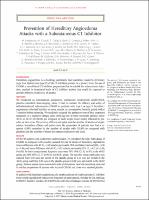| dc.contributor | Vall d'Hebron Barcelona Hospital Campus |
| dc.contributor.author | Longhurst, Hilary |
| dc.contributor.author | Cicardi, Marco |
| dc.contributor.author | Craig, Timothy |
| dc.contributor.author | Bork, Konrad |
| dc.contributor.author | Grattan, Clive |
| dc.contributor.author | Baker, James |
| dc.contributor.author | Guilarte Clavero, Mar |
| dc.date.accessioned | 2019-03-15T12:07:54Z |
| dc.date.available | 2019-03-15T12:07:54Z |
| dc.date.issued | 2017-03-23 |
| dc.identifier.citation | Longhurst H, Cicardi M, Craig T, Bork K, Grattan C, Baker J, et al. Prevention of Hereditary Angioedema Attacks with a Subcutaneous C1 Inhibitor. N Engl J Med. 2017; 376(12):1131–1140. |
| dc.identifier.issn | 0028-4793 |
| dc.identifier.uri | https://hdl.handle.net/11351/3846 |
| dc.description | Prevention; Angioedema attack; C1 inhibitor |
| dc.description.abstract | BACKGROUND:
Hereditary angioedema is a disabling, potentially fatal condition caused by deficiency (type I) or dysfunction (type II) of the C1 inhibitor protein. In a phase 2 trial, the use of CSL830, a nanofiltered C1 inhibitor preparation that is suitable for subcutaneous injection, resulted in functional levels of C1 inhibitor activity that would be expected to provide effective prophylaxis of attacks.
METHODS:
We conducted an international, prospective, multicenter, randomized, double-blind, placebo-controlled, dose-ranging, phase 3 trial to evaluate the efficacy and safety of self-administered subcutaneous CSL830 in patients with type I or type II hereditary angioedema who had had four or more attacks in a consecutive 2-month period within 3 months before screening. We randomly assigned the patients to one of four treatment sequences in a crossover design, each involving two 16-week treatment periods: either 40 IU or 60 IU of CSL830 per kilogram of body weight twice weekly followed by placebo, or vice versa. The primary efficacy end point was the number of attacks of angioedema. Secondary efficacy end points were the proportion of patients who had a response (≥50% reduction in the number of attacks with CSL830 as compared with placebo) and the number of times that rescue medication was used.
RESULTS:
Of the 90 patients who underwent randomization, 79 completed the trial. Both doses of CSL830, as compared with placebo, reduced the rate of attacks of hereditary angioedema (mean difference with 40 IU, -2.42 attacks per month; 95% confidence interval [CI], -3.38 to -1.46; and mean difference with 60 IU, -3.51 attacks per month; 95% CI, -4.21 to -2.81; P<0.001 for both comparisons). Response rates were 76% (95% CI, 62 to 87) in the 40-IU group and 90% (95% CI, 77 to 96) in the 60-IU group. The need for rescue medication was reduced from 5.55 uses per month in the placebo group to 1.13 uses per month in the 40-IU group and from 3.89 uses in the placebo group to 0.32 uses per month in the 60-IU group. Adverse events (most commonly mild and transient local site reactions) occurred in similar proportions of patients who received CSL830 and those who received placebo.
CONCLUSIONS:
In patients with hereditary angioedema, the prophylactic use of a subcutaneous C1 inhibitor twice weekly significantly reduced the frequency of acute attacks. (Funded by CSL Behring; COMPACT EudraCT number, 2013-000916-10 , and ClinicalTrials.gov number, NCT01912456). |
| dc.language.iso | eng |
| dc.publisher | Massachusetts Medical Society |
| dc.relation.ispartofseries | New England Journal of Medicine;376(12) |
| dc.rights | Attribution-NonCommercial-NoDerivatives 4.0 International |
| dc.rights.uri | http://creativecommons.org/licenses/by-nc-nd/4.0/ |
| dc.source | Scientia |
| dc.subject | Edema - Prevenció |
| dc.subject | Enzims proteolítics - Inhibidors |
| dc.subject | Injeccions hipodèrmiques |
| dc.subject.mesh | Angioedemas, Hereditary |
| dc.subject.mesh | /prevention & control |
| dc.subject.mesh | Complement C1 Inhibitor Protein |
| dc.subject.mesh | /administration & dosage |
| dc.subject.mesh | Injections, Subcutaneous |
| dc.title | Prevention of Hereditary Angioedema Attacks with a Subcutaneous C1 Inhibitor |
| dc.type | info:eu-repo/semantics/article |
| dc.identifier.doi | 10.1056/NEJMoa1613627 |
| dc.subject.decs | angioedemas hereditarios |
| dc.subject.decs | /prevención & control |
| dc.subject.decs | proteína inhibidora del complemento C1 |
| dc.subject.decs | /administración & dosificación |
| dc.subject.decs | inyecciones subcutáneas |
| dc.relation.publishversion | https://www.nejm.org/doi/10.1056/NEJMoa1613627 |
| dc.type.version | info:eu-repo/semantics/publishedVersion |
| dc.audience | Professionals |
| dc.contributor.organismes | Institut Català de la Salut |
| dc.contributor.authoraffiliation | [Longhurst H] Barts Health NHS Trust, London, United Kingdom. [Cicardi M] Ospedale Luigi Sacco–U.O. Medicina Generale, Milan, Italy. [Craig T] Department of Medicine and Pediatrics, Penn State Hershey Allergy, Asthma, and Immunology, Hershey, United States. [Bork K] Johannes Gutenberg University Mainz, Mainz, Germany. [Grattan C] St. John’s Institute of Dermatology, Guy’s Hospital, London, United Kingdom. [Baker J] Baker Allergy, Asthma and Dermatology Research Center, Portland, United States. [Guilarte M] Hospital Universitari Vall d'Hebron, Barcelona, Spain. |
| dc.identifier.pmid | 28328347 |
| dc.identifier.wos | WOS:000397014300009 |
| dc.rights.accessrights | info:eu-repo/semantics/openAccess |

